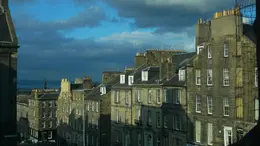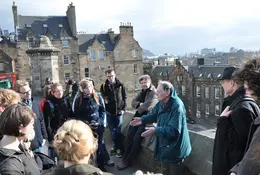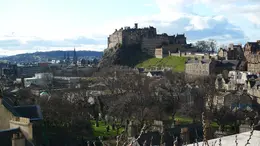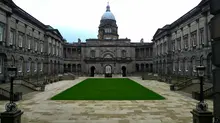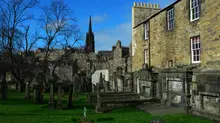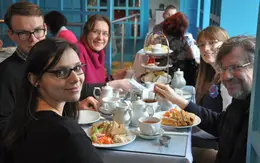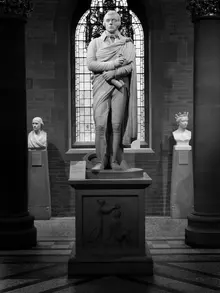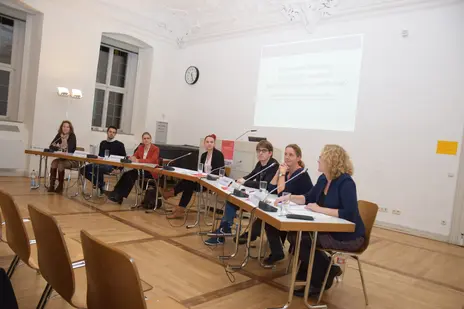Study Trip to Edinburgh
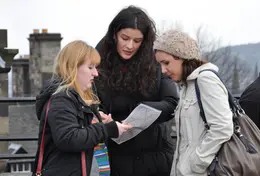
From February 29 to March 5, 2012 a group of 30 students and professors flew to Edinburgh, the capital city of Scotland for a study visit.
Historical Edinburgh: Of Kings, Queens & Thinkers
After spending the larger part of the first day travelling to Scotland, we began our sojourn in the country’s capital with a relaxing dinner and an evening in Edinburgh’s pubs and bars. More or less rested, the group was taken on a tour through the historical Edinburgh by Roy Pinkerton, a former professor at the University of Edinburgh, and Christoph Heyl, a colleague from the University of Essen who has taught at Bamberg before.
Beginning with Greyfriars Kirkyard, we walked to Edinburgh Castle, an ancient structure which rises high above the city, served as a royal residence for Scotland’s kings and queens throughout the Middle Ages, and later, after the so-called ‘Joining of Crowns,’ was turned into a military basis of historically varying importance. Following a tour through the castle grounds (f. ex. St. Margaret’s Chapel, the National War Museum, the Royal Palace) Prof. Pinkerton led the group down the Royal Mile explaining the historical sights and architecture along this ‘spine’ of old Edinburgh.
The next day again, Prof. Pinkerton made it possible for the participants of the excursion to see the library of the University of Edinburgh where we heard presentations on one period central to the city’s history like few others: the Scottish Enlightenment. During the 18th century, Edinburgh had slowly developed to become one of the intellectual capitals of Europe due to its university, but also because of its famous scientists, philosophers and poets, like James Hutton, David Hume and Robert Burns. Some of these great figures we were able to encounter again and learn more about later that day during a visit of the National Portrait Gallery.´
Gothic Edinburgh: Of Poets, Grave Diggers & Body Snatchers
Edinburgh, students learned, was not only a city of enlightened thinking; it was also one of deeply shadowy dealings. On the occasion of our visit of Greyfriars Kirkyard, as well as during our walks through the city, Prof. Heyl and several student presentations thus pointed out the relics of Edinburgh’s darkest histories, the most memorable of which certainly the encaged graves on the old cemetery, constructed to prevent body snatchers from digging up the freshly buried. As the city’s advances in medicine increased the demand for corpses, unscrupulous men had made it their business to dig up bodies to sell them, and even to kill people in order to procure their horrific merchandise.
That such events, along with the city’s particular atmosphere might have influenced the works of many writers, quickly began to make sense. Among these authors whose texts were in this manner inspired, it hast been argued, were famous authors of the past, like Sir Arthur Conan Doyle (Stories of Sherlock Holmes) or Robert Louis Stevenson (The Strange Case of Dr Jekyll and Mr Hyde), as well as of the present, like Scottish crime writer Ian Rankin and J. K. Rowling.
Theatre trip to Glasgow
Following the tradition of the study trips of the past years, we had to use the opportunity to profit at least a little bit of the lively Scottish theatre scene. After having enjoyed the performance of a comic improvisation group in Edinburg, we took a day trip to Glasgow in order to watch two plays at the Theatre Royal and the Citizens Theatre respectively: first, An Appointment with the Wicker Man, a musical parody of the 1973 horror film and cult classic The Wicker Man produced by the National Theatre of Scotland, and second, Harold Pinter’s Betrayal, a play subtly exploring the hidden emotions and motivations of its three protagonists in a love triangle. Despite its comic character, especially Wicker Man exemplified once more a national consciousness of the kind one also finds in many of Edinburgh’s museums, art galleries and tributes to its most celebrated literary figures. It is a national consciousness rooted in both histories and stories, facts and fictions, past and present.
Edinburgh - Where Scotland’s Past Meets Its Future
In fact, one could say, the entire city of Edinburgh embodies this national consciousness oscillating between past and present. Whether one is standing on Calton Hill with view of the port and the National Monument, or on Arthur’s Seat with view of the entire city, old and new, it becomes clear that Edinburgh is both mindful of her history and busy reinventing herself. In this context, Scotland’s capital is a place whose identity, like that of the entire country, is also very much directed toward the future, as we realized especially during our visit to the new Parliament Building, where plans have been made for a referendum deciding on Scottish independence as soon as 2014.
Edinburgh is a fascinating city brimming with history and buzzing with life which makes a study trip worth while in ways impossible to detail. So, thank you to Prof. Christoph Houswitschka for bringing in Prof. Pinkerton and Prof. Heyl as guides to the city’s many riches; thank you also to Susan Brähler, Barbara Kehler and Nicole Konopka for the participation and to Johannes Weber in particular, for the flawless organization of this 2012 excursion. Those who could not attend, I dare say, have missed out on something amazing and should look forward to the next study trip organized by the department of English Literature.
Judith Rauscher
